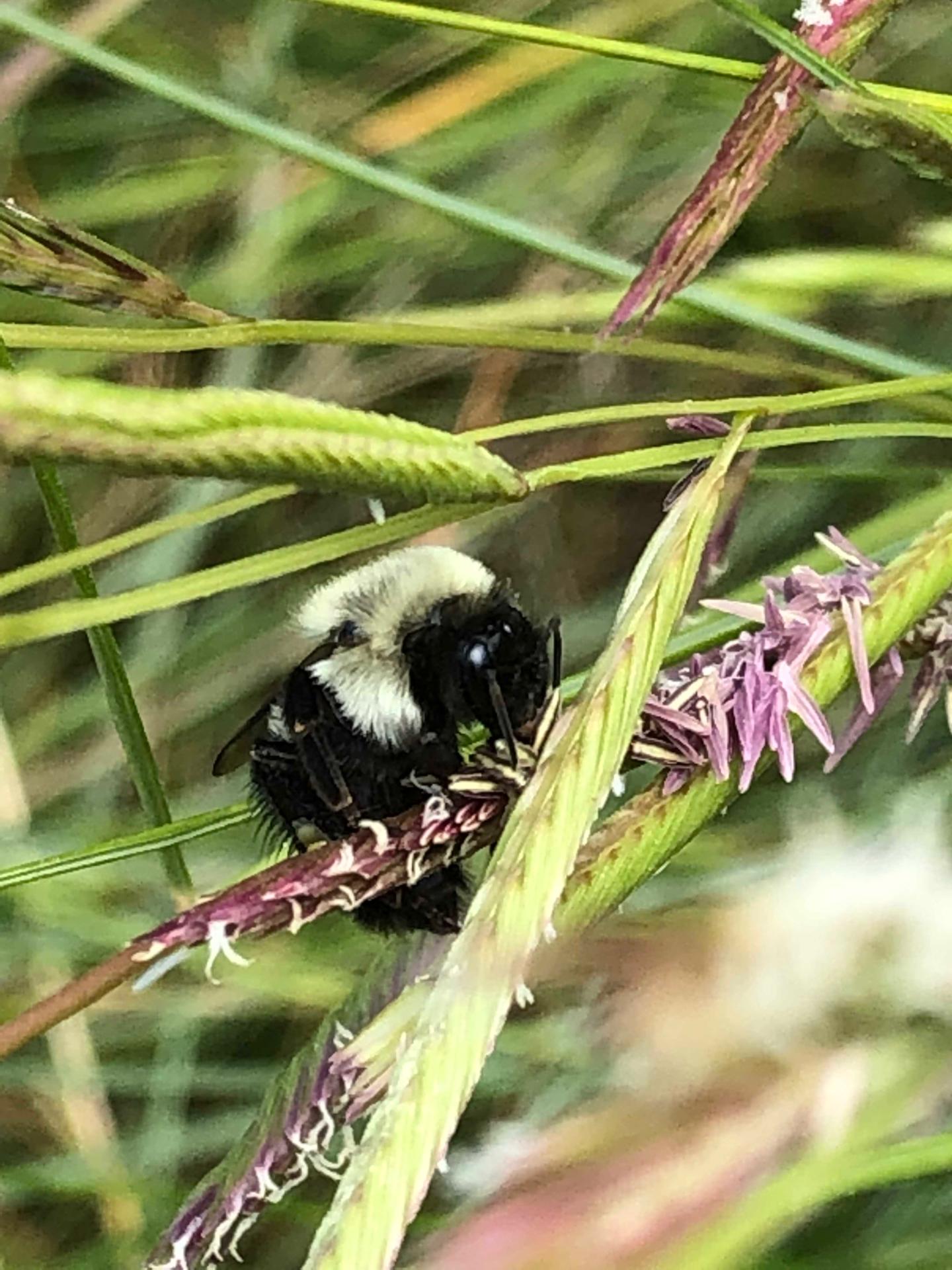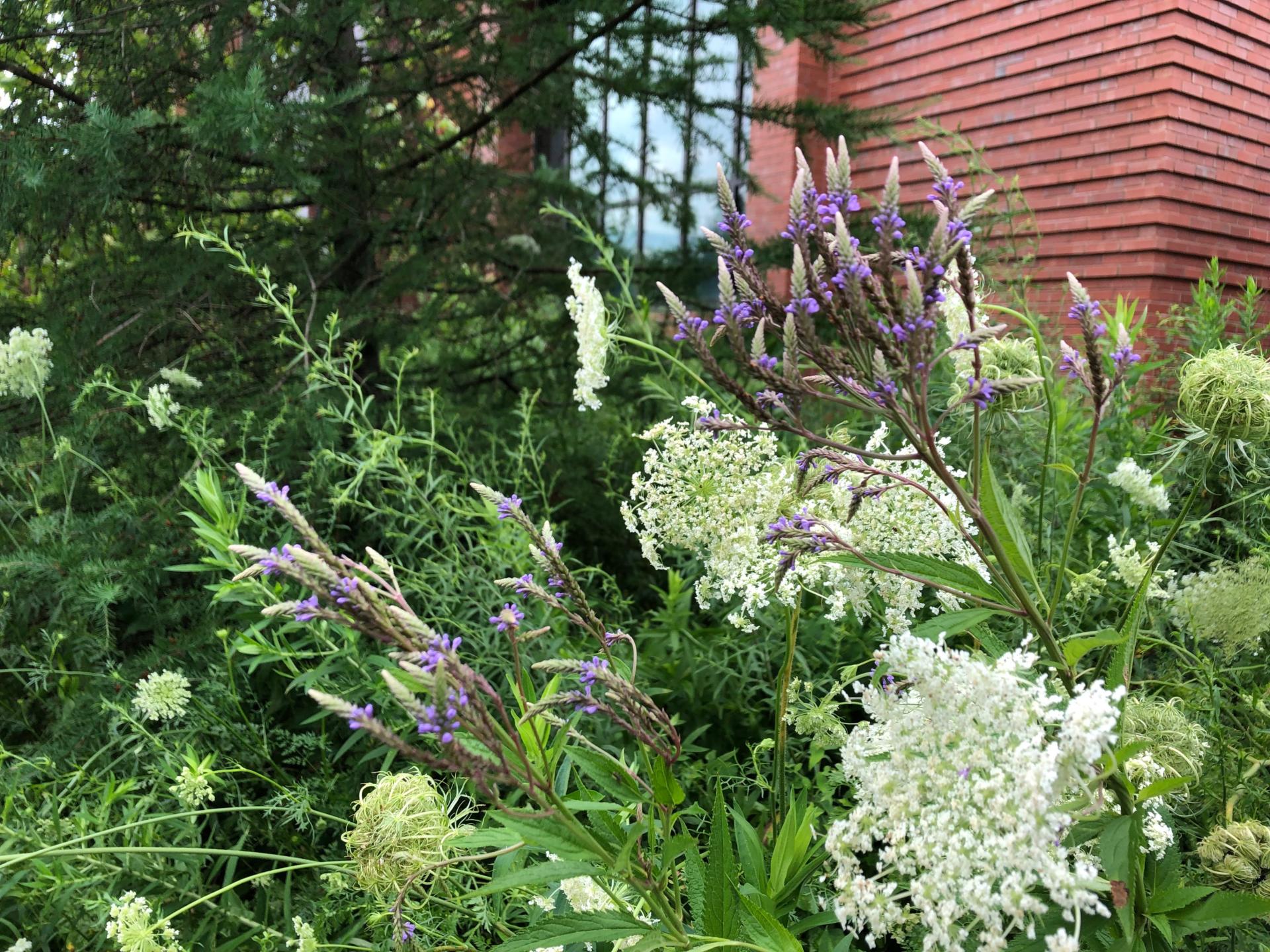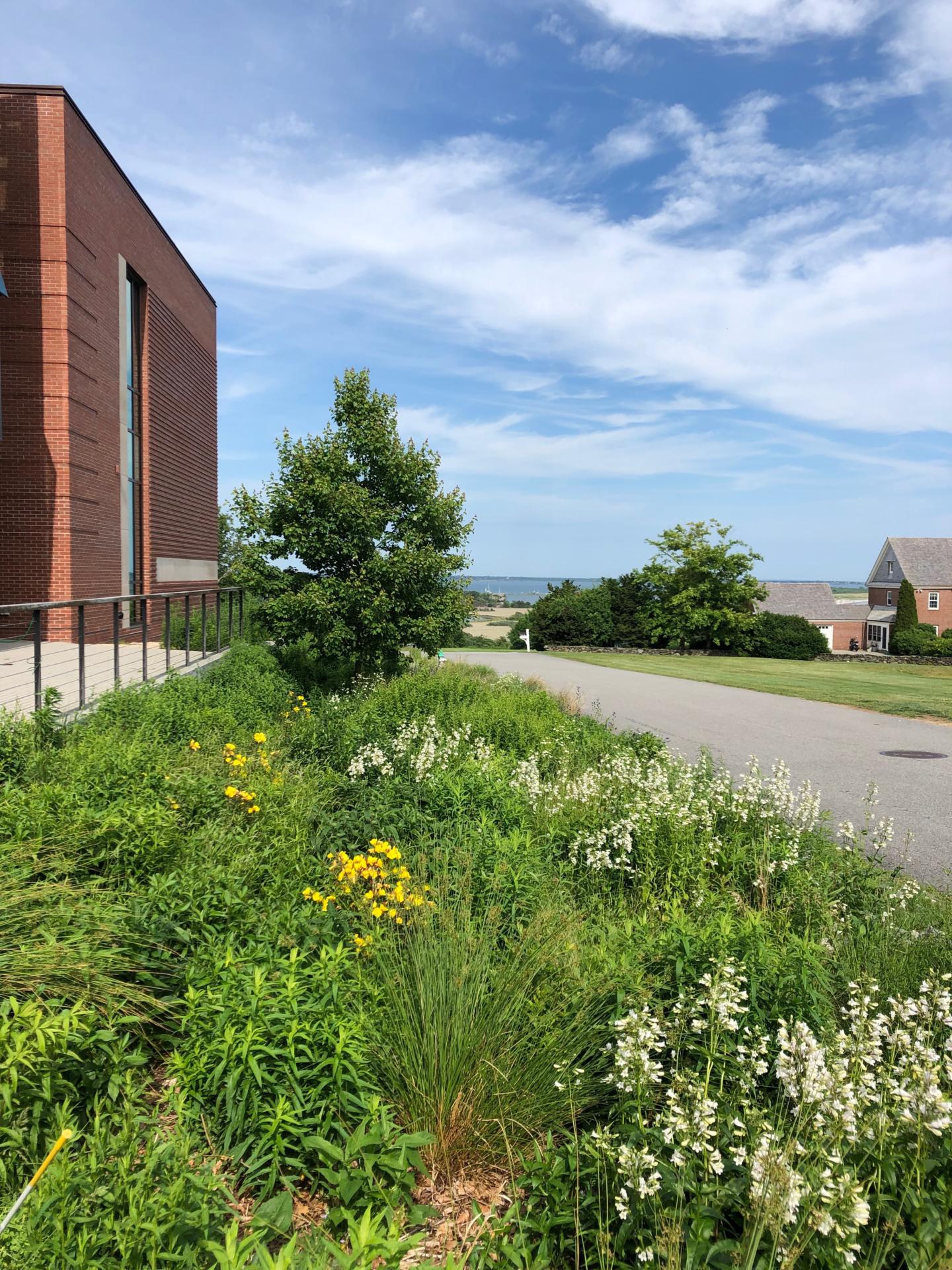by Lori Silvia
The responsibility I feel towards the landscape surrounding the Academic Center at Rhode Island’s St. George’s School is real, endless, and heartfelt. To me, it is work of joyful connection and reciprocity, inner guided and outwardly researched. Experimental and with unexpected results and returns. Honestly, at times, I’ve felt intense, tearful, on-the-verge-of quitting frustration, but have experienced more times of peaceful interconnectedness and grateful reverence standing in its beauty while noticing up close, all the amazing diversity I helped to bring into a once sterile construction zone.
For many participants in the project, even if they did professional quality work, it was another job. I realized early on that I was the only one who passionately cared for this project, and I felt determined to help others understand the concept of natural inspiration and the reflective placement of plant material I envisioned when I stood in the unplanted landscape. Building a landscape from nothing can forge a meaningful and thoughtful relationship. For me, the process and details are important, the hours imagining the landscape can be filtered intuitively while building the landscape. Currently, I think most people acknowledge the required labor, but without the physical understanding; most people have forgotten the importance of the emotional relationship and reciprocity towards the earth and the bounty it gives. “We” often take without giving; “we” often do without thinking. Every choice we make, affects what happens around us, like a pebble being tossed into a still pond.

St. George’s wild fields overlook Sachuest National Wildlife Refuge and Norman Bird Sanctuary conservation land.
Recognizing the Design Problem
Reflecting upon the development process in the winter of 2015, it began when I was asked to review another landscape architect’s plan for this project. I now recognize that the entire plan was disconnected. Disconnected from the sense of place and the spectacular view from “The Hilltop,” the nickname for our school. Disconnected from the new Academic Center’s design and scale, from the rest of our beautiful campus, and from the land that we share with many diverse and protected coastal habitats. In my opinion, the proposed design had the potential to disengage visitors from the landscape, block the view, and ignore seasonal interest during the school year. It proposed monocultures in giant blocks, which appeared more like invasive species rather than native plant communities. It checked the LEED boxes (e.g., proposed many native plants, kept water on site); however, it did not honor plants’ natural habitats, biodiversity, or wildlife support, and completely ignored the visitor’s experience, ecological techniques, and logistics for maintenance.
Despite my efforts to collaborate and to introduce a more dynamic native plant palette and integrated design, my ideas were dismissed. But, I knew the space and I knew this project was an opportunity to design a meaningful and beautiful landscape that aligned with the contoured site engineering plan. However, I had a very short time to convince everyone that my different vision and guidance would greatly benefit this project. I quickly developed a new concept, researched seasonal plant lists, created a design and drawings, conducted meetings, selected the physical plants. I had to sell this new plan and to say I felt rushed is an understatement. However, it is perhaps in these times that we can depend on our intuition and our instincts to guide us while letting everything we’ve learned thus far percolate. I was educated and passionate, but I had to project confidence so that I could direct the job. Only four months later the results of my efforts were on display. After the install crews left every day and it was quiet, I stayed, alone, observing, planting more, photographing, and taking field notes.

In winter, Cornus sericea, various seed heads, and Schizachyrium scoparium become prominent in the landscape.
Tracking Success
Many times during that first year I was discouraged and impatient, yet each surviving plant, shrub, and tree, every new blossom was the gift of motivation. Every day, I considered what it was I was trying to achieve and nurture, and I kept planting. I observed, learned, experimented, planted, documented, researched, refined my original ideas, and determined how I could make the landscape better. Being on site daily for the last five years has allowed me to address issues as they arose, and each year has birthed a new landscape as nature started to take over. Finally, I became the landscapes partner instead of parent.
I am inspired by designers and scientists that bring forth landscapes designed to be more connected, sensitive, and integrated, and feel fortunate and grateful to those who have written profound books and given thoughtful lectures. I hope to do the same. One person can’t be responsible for knowing everything. However, collectively we can share our knowledge and our experience. We can collaborate, and then we all become teachers. Although we can find answers, solutions, and inspiration across the internet and within publications, it is important to communicate directly with each other and to have conversations about the successes and difficulties of our experiences. I don’t want to falsely portray a glossed over social media portrait of how this landscape evolved. Honestly, there were times in the past five years I’ve wanted to leave the overwhelming demands of this job I do by myself. My body ached too much, bureaucracy slowed progress too much. However, this landscape provides so many lessons, and pulls me back in, especially during these quiet and glorious moments that I alone have been gifted to observe.

An ecological design blurs the line between the planted landscape and the inspirational natural landscape.
Let Nature Teach
So how does an ecological landscape designer or architect, with deadlines and computers, go about designing with connections in mind? The simple answer is to look at nature as a teacher. Make time to go to the site, experience the surrounding areas. Explore, observe and photograph different habitats, especially the ones that inspire you and can guide and inform your designs. For example, if you’re designing raingardens go explore local wetlands, stream banks, roadside wet ditches, and fields. See where plants are in natural placement and combinations. Maybe spend weekends in nature away from the office, computer, and cell phone. Leave working behind and let noticing begin.

Whether it is the sound of Spartina patens in the wind or the bumble bee that pollinates it, find what connects people with the landscape.
Quietly and slowly walking in nature while opening the senses can be the doorway to finding connections. This observational and sensory approach could percolate through you and inspire new ideas. Maybe return to hand sketching to connect brain, heart, and hand. Consider the experiences of indigenous people and family farmers who have respect and reverence for the landscapes they plant, grow, care for, and harvest. If your work is for a client, ask them their connection to nature as a child, or a positive nature experience they remember. Everyone, no matter where they grew up, will have at least one connection if you ask them to think about it. Ask what colors they love and whether they have favorite flowers or plant fragrances? Find plants for your landscape design that can be people connectors, providing the feeling of “I know this!” That’s your hook to get people to come in closer, deeper.

Self seeding Verbena hastata and Daucus carota fill in where something was missing from the landscape.
In the future, we might need to create and provide new nature experiences for our clients. If you’re in your 50’s, like me, you probably played and explored outside far and wide in your neighborhood’s natural habitats. This freedom is now lost to our children. Many of our grandparents and older relatives may have grown some of their own vegetables or had fruit trees. I remember my grandfather’s pear tree, Concord grape arbor, luscious tomatoes, and his early morning vegetable deliveries to our doorstep. His extensive organic gardens provided for my grandmother, who was a fabulous cook, and he delivered “extras” to us and to the neighbors. He wanted nothing in return besides a good meal or a smile. As a child, I thought it was fun to shadow him around and took for granted all the hard work and love that went into the landscape that he nurtured and cared for, but now I know.
Circling back to the pebble (you) tossed into the pond (your landscape projects), and those concentric ripples spreading outward (the environment), in what ways do your design AND maintenance plan benefit and support ecological biodiversity and the health of the environment? How will the landscape engage people, pollinators and insects, birds and wildlife, beauty and place? How far and wide do those ripples project outward? Are you being a good steward, a good teacher? Each project has greater potential to make a difference, and there are so many possibilities. Most importantly, in order to change how the general population perceives ecological and naturalistic landscape designs, we need to inspire, to explain, to educate about the purpose and intent and to talk about those concentric ripples.
About the Author
Lori Silvia has a BFA from Mass College of Art & Design and graduated from The Landscape Institute, Arnold Arboretum of Harvard University. A collaboration of art, landscape design, science, and intuition is part of her vision. She has been a landscape designer and gardener at St. George’s School since 2008, creating LEED-certified ecological designs for the newly-built Hill Library and Academic Center and renovating nearly every corner of the campus in some way. Ms. Silvia is dedicated to experiential learning and lectures to students and the greater community.
***
Each author appearing herein retains original copyright. Right to reproduce or disseminate all material herein, including to Columbia University Library’s CAUSEWAY Project, is otherwise reserved by ELA. Please contact ELA for permission to reprint.
Mention of products is not intended to constitute endorsement. Opinions expressed in this newsletter article do not necessarily represent those of ELA’s directors, staff, or members.






